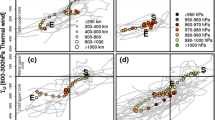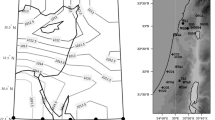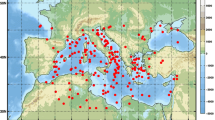Abstract
Regional climate model projections over the Mediterranean region are analysed for the presence of intense, warm-core lows that share some of the characteristics of tropical cyclones. The results indicate that the number of such systems decreases in a warmer world, particularly in winter. Comparison of the simulated numbers to changes in relevant climate diagnostics suggests that numbers decrease due to an increasingly hostile environment for storm formation, combined with a general poleward shift in the incidence of wintertime lows over western Europe.












Similar content being viewed by others
References
Bister M, Emanuel K (1998) Dissipative heating and hurricane intensity. Meteorol Atmos Phys 50:233–240
Briegel LM, Frank WM (1997) Large-scale influences on tropical cyclogenesis in the western North Pacific. Mon Weather Rev 125:1397–1413
Campins J, Genoves A, Picornell MA, Jansa A (2010) Climatology of Mediterranean cyclones using the ERA-40 dataset. Int J Climatol 31:1596–1614
Cavicchia L, von Storch H (2012) The simulation of medicanes in a high-resolution regional climate model. Clim Dyn 39:2273–2290
Christensen J, Carter T, Giorgi F (2002) PRUDENCE employs new methods to assess European climate change. EOS 83:147
Dickinson RE, Henderson-Sellers A, Kennedy PJ (1993) Biosphere–atmosphere transfer scheme (BATS) version 1E as coupled to the NCAR community climate model. NCAR Tech Rep. TN-387+STR, p 72
Eady ET (1949) Long waves and cyclone waves. Tellus 1:33–52
Efimov VV, Stanichnyi SV, Shokurov MV, Yarovaya DA (2008) Observations of a quasi-tropical cyclone over the Black Sea. Russ Meteorol Hydrol 33:233–239
Emanuel K (2005) Genesis and maintenance of Mediterranean hurricanes. Adv Geosci 2:217–220
Fita L, Romero R, Luque A, Emanuel K, Ramis C (2007) Analysis of the environments of seven Mediterranean storms using an axisymmetric, nonhydrostatic cloud model. Nat Hazards Earth Syst Sci 7:41–56
Flocas HA, Simmonds I, Kouroutzoglou J, Keay K, Hatzaki M, Bricolas V, Demosthenes A (2010) On cyclonic tracks over the eastern Mediterranean. J Clim 23:5243–5257
Gaertner MA, Jacob D, Gil V, Domınguez M, Padorno E, Sanchez E, Castro M (2007) Tropical cyclones over the Mediterranean Sea in climate change simulations. Geophys Res Lett 34. doi:10.1029/2007GL029977
Gaertner MA, Gil V, Romera R, Domínguez M, Sánchez E, Gallardo C (2011) Climate change scenarios and risk of tropical cyclones over the Mediterranean Sea: analysis with ENSEMBLES data. Presented at the 3rd International Summit on Hurricanes and Climate Change, June 27–July 2, 2011, Rhodes
Giorgi F, Coppola E (2007) European climate-change oscillation (ECO). Geophys Res Lett 34:L21703
Giorgi F, Marinucci MR, Bates GT (1993a) Development of a second generation regional climate model (REGCM2). Part I: boundary layer and radiative transfer processes. Mon Weather Rev 121:2794–2813
Giorgi F, Marinucci MR, Bates GT, DeCanio G (1993b) Development of a second generation regional climate model (REGCM2). Part II: convective processes and assimilation of lateral boundary conditions. Mon Weather Rev 121:2814–2832
Grell GA (1993) Prognostic evaluation of assumptions used by cumulus parameterizations. Mon Weather Rev 121:764–787
Hart R (2003) A cyclone phase space derived from thermal wind and thermal asymmetry. Mon Weather Rev 131:585–616
Haurwitz B (1935) The height of tropical cyclones and the eye of the storm. Mon Weather Rev 63:45–49
Hewitt CD, Griggs DJ (2004) Ensembles-based predictions of climate changes and their impacts. EOS 85:566
Holtslag AAM, de Bruijn EIF, Pan HL (1990) A high resolution air mass transformation model for short-range weather forecasting. Mon Weather Rev 118:1561–1575
Kiehl JT, Hack JJ, Bonan GB, Boville BA, Briegleb BP, Williamson DL, Rasch PJ (1996) Description of the NCAR community climate model (CCM3).NCAR Tech Rep. TN-420+STR, p 152
Kistler K, Kalnay E, Collins W, Saha S, White G, Woollen J, Chelliah M, Ebisuzaki W, Kanamitsu M, Kousky V, van den Dool H, Jenne R, Fiorino M (2001) The NCEP–NCAR 50-year reanalysis: monthly means CD-ROM and documentation. Bull Am Meteorol Soc 82:247–267
Lagouvardos K, Kotroni V, Nickovic S, Jovic D, Kallos G, Tremback CJ (1999) Observations and model simulations of a winter sub-synoptic vortex over the central Mediterranean. Meteorol Appl 6:371–383
Landman WA, Seth A, Camargo SJ (2005) The effect of regional climate model domain choice on the simulation of tropical cyclone-like vortices in the southwestern Indian Ocean. J Clim 18:1263–1274
Lavaysse C, Flamant C, Janicot S, Knippertz P (2010) Links between African easterly waves, midlatitude circulation and intraseasonal pulsations of the West African heat low. Q J R Meteorol Soc 136:141–158
Lionello P, Boldrin U, Giorgi F (2008) Future changes in cyclone climatology over Europe as inferred from a regional climate simulation. Clim Dyn 30:657–671
Maheras P, Flocas HA, Patrikas I, Anagnostopoulou C (2001) A 40-year objective climatology of surface cyclones in the Mediterranean region: spatial and temporal distribution. Int J Climatol 21:109–130
Mayengon R (1984) Warm core cyclones in the Mediterranean. Mar Wea Log 28:6–9
Murray RJ, Simmonds I (1991a) A numerical scheme for tracking cyclone centres from digital data. Part I: development and operation of the scheme. Aust Meteor Mag 39:155–166
Murray RJ, Simmonds I (1991b) A numerical scheme for tracking cyclone centres from digital data. Part II: application to January and July general circulation model simulations. Aust Meteor Mag 39:167–180
Nakicenovic N, Swart R (2000) IPCC special report on emissions scenarios. Cambridge University Press, Cambridge 570 p
Paciorek CJ, Risbey JS, Ventura V, Rosen RD (2002) Multiple indices of Northern Hemisphere cyclone activity, winters 1949–99. J Clim 15:1573–1590
Pal JS, Small EE, Eltahir EAB (2000) Simulation of regional scale water and energy budgets: influence of a new moist physics scheme within RegCM. J Geophys Res 105:29579–29594
Pal JS, Giorgi F, Bi X, Elguindi N, Solmon F, Gao X, Rauscher SA, Francisco R, Zakey A, Winter J, Ashfaq M, Syed FS, Bell JS, Diffenbaugh NS, Karmacharya J, Konare A, Martinez D, Da Rocha RP, Sloan LC, Steiner AL (2007) Regional climate modeling for the developing world: the ICTP RegCM3 and RegCNET. Bull Am Meteorol Soc 88:1395–1409
Pezza AB, Simmonds I (2005) The first South Atlantic hurricane: unprecedented blocking, low shear and climate change. Geophys Res Lett 32:L15712. doi:10.1029/2005GL023390
Picornell MA, Jansa J, Genove A, Campins J (2001) Automated database of mesocyclones from the HIRLAM-0.5 analyses in the western Mediterranean. Int J Climatol 21:335–354
Pytharoulis I, Craig GC, Ballard SP (2000) The hurricane-like Mediterranean cyclone of January 1995. Meteorol Appl 7:261–279
Reale O, Atlas R (2001) Tropical cyclone-like vortices in the extratropics: observational evidence and synoptic analysis. Wea Forecast 16:7–34
Roeckner E, Bauml G, Bonaventura L, Brokopf R, Esch M, Giorgetta M, Hagemann S, Kirchner I, Kornblueh L, Manzini E, Rhodin A, Schlese U, Schulzweida U, Tompkins A (2003) The atmospheric general circulation model ECHAM5. Part I: model description. Rep. No. 349, Max-Planck-Institut für Meteorologie, Hamburg, Germany, p 127
Schepanski K, Knippertz P (2011) Soudano–Saharan depressions and their importance for precipitation and dust: a new perspective on a classical synoptic concept. Q J R Meteorol Soc 137:1431–1445
Shapiro LJ (1987) Month-to-month variability of Atlantic tropical circulation and its relationship to tropical cyclone formation. Mon Weather Rev 115:2598–2614
Shapiro MA, Keyser D (1990) Fronts, jet streams and the tropopause. In: Newton CW, Holopainen EO (eds) Extratropical cyclones, the Erik Palmen memorial volume. American Meteorological Society, Boston, pp 167–191
Simmonds I, Lim E-P (2009) Biases in the calculation of Southern Hemisphere mean baroclinic eddy growth rate. Geophys Res Lett 36:L01707. doi:10.1029/2008GL036320
Tous M, Romero R (2011) Medicanes: criteris de catalogació i exploració dels ambient meteorològics. Tethys 8:53–61
Tous M, Romero R (2013) Meteorological environments associated with medicane development. Int J Climatol 33:1–14
Tous M, Romero R, Ramis C (2010) Medicanes: database and environmental parameters. EGU Abstracts 2010, vol 12, EGU2010-12620
Ulbrich U, Christoph M (1999) A shift in the NAO and increasing storm track activity over Europe due to anthropogenic greenhouse gas. Clim Dyn 15:551–559
Uppala SM, KÅllberg PW, Simmons AJ, Andrae U, Bechtold VDC, Fiorino M, Gibson JK, Haseler J, Hernandez A, Kelly GA, Li X, Onogi K, Saarinen S, Sokka N, Allan RP, Andersson E, Arpe K, Balmaseda MA, Beljaars ACM, Berg LVD, Bidlot J, Bormann N, Caires S, Chevallier F, Dethof A, Dragosavac M, Fisher M, Fuentes M, Hagemann S, Hólm E, Hoskins BJ, Isaksen L, Janssen PAEM, Jenne R, Mcnally AP, Mahfouf J-F, Morcrette J-J, Rayner NA, Saunders RW, Simon P, Sterl A, Trenberth KE, Untch A, Vasiljevic D, Viterbo P, Woollen J (2005) The ERA-40 re-analysis. Q J R Meteorol Soc 131:2961–3012
Vallis GK (2006) Atmospheric and oceanic dynamics: fundamentals and large-scale circulation. Cambridge University Press, New York 744 p
Walsh KJE, Nguyen K-C, McGregor JL (2004) Fine-resolution regional climate model simulations of the impact of climate change on tropical cyclones near Australia. Clim Dyn 22:47–56
Ziv B, Dayan U, Sharon D (2005) A mid-winter, tropical extreme flood-producing storm in southern Israel: synoptic scale analysis. Meteorol Atmos Phys 88:53–63
Acknowledgments
The first author would like to thank the University of Melbourne and ICTP, which both provided partial funding for his visit to ICTP in October–December 2010. The authors would also like to thank the Commonwealth Scientific and Industrial Research Organisation (CSIRO) for the use of their tropical cyclone tracking scheme.
Author information
Authors and Affiliations
Corresponding author
Rights and permissions
About this article
Cite this article
Walsh, K., Giorgi, F. & Coppola, E. Mediterranean warm-core cyclones in a warmer world. Clim Dyn 42, 1053–1066 (2014). https://doi.org/10.1007/s00382-013-1723-y
Received:
Accepted:
Published:
Issue Date:
DOI: https://doi.org/10.1007/s00382-013-1723-y




